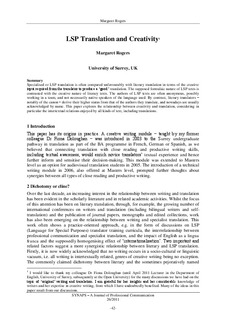| dc.description.abstract | Specialised or LSP translation is often compared unfavourably with literary translation in terms of the creative input required from the translator to produce a „good‟ translation. The supposed formulaic nature of LSP texts is contrasted with the creative nature of literary texts. The authors of LSP texts are often anonymous, possibly working in a team, and not necessarily native speakers of the language used. By contrast, literary translators − notably of the canon − derive their higher status from that of the authors they translate, and nowadays are usually acknowledged by name. This paper explores the relationship between creativity and translation, considering in particular the intertextual relations enjoyed by all kinds of text, including translations. | nb_NO |
